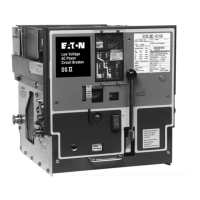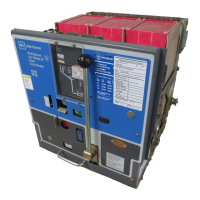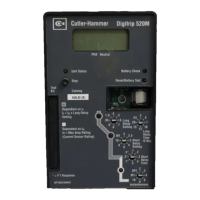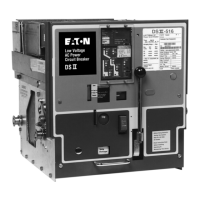I.
B.
694C694-02
horizontal dead center of the crank arms is reached, the
torque of the closing springs starts to rotate the crank
independently of the driving motor. However, the stop
roller on the closing cam quickly stops the movement of
the crank at only a few degrees over center, and holds it
there by coming against the spring release latch. This is
the "spring charged" position. The motor cut-off switch
cam (7) operates the switch (15) through a lever (13) at
this time, and the motor stops.
At the instant the springs snap over dead center, the
lobes of the drive plates raise the pawl lifters (27), and
prevent the oscillator pawl (28) from engaging the next
tooth in the ratchet wheel. Thus the oscillator is free and
renders the exact stopping point of the motor not critical.
When the spring release latch is moved below the level
of the stop roller, the close cam is free to rotate; and the
two closing springs rotate the crankshaft counterclock-
wise to close the breaker contacts. They assume the
position shown in Figure
4-6b and the cam as shown in
Figure
4-7c. During rotation, the drive plates move away
from the ratchet wheel pin. The ratchet wheel does not
rotate during the closing operation, thus preventing
excessive wear on the teeth and pawls.
Power operated breakers are also equipped for emer-
gency hand charging of the closing springs (Figure
4-8).
This operation is similar to that of the motor and oscilla-
tor except a separate emergency charge pawl (33) is
used to advance the ratchet wheel (17) several teeth on
each stroke of the charge handle (34). This device (26)
also pivots on the crank shaft.
4-2.2 POWER OPERATION
Refer to Figure 4-9 for the basic schematic and connec-
tion diagrams.
With the breaker open and springs discharged, the
motor is energized through the limit switch (LS) and the
"b" contact. The green indicating light (G) is controlled
by a separate "b" contact, and when lit indicates the
breaker is open.
The motor runs and charges the closing springs. When
the springs are fully charged, the limit switch (LS) opens
in the motor circuit and closes in the spring release coil
(SR) circuit.
When the close contact (CS-C) makes, the spring
release coil (SR) is energized through the normally
closed
''Y'' contact, the limit switch (LS), and the breaker
"b" contacts. This releases the latch holding the stop
roller on the close cam.
Effective
07
/97
Page
29
The springs are released to close the breaker. When the
breaker closes, the "b" contact opens to cut off the
spring release coil (SR) and motor (MOT), and the limit
switch (LS) contacts reset.
If the close contact (CS-C) is maintained, the anti-pump
relay
(Y)
will be picked up by the current through the
spring release coil (SR), and will open its "Y" contact in
the spring release (SR) circuit. This allows only one
close
operation until the close contact (CS-C) has been
reset. The "Y" coil has a very low drop-out voltage.
On some breakers a special closing circuit may be pro-
vided which permits the closing springs to be automatical-
ly recharged immediately after the breaker is closed,
instead of only after the breaker is opened. This is
accomplished by separating the motor and limit switch
from the "b" contact so the motor operation is indepen-
dent of the position of the breaker contacts. This arrange-
ment makes the breaker suitable for use with instanta-
neous reclosing relays or
in
special operating sequences.
Standard control utilizes AC or DC control power. For
240 or 120 volt AC equipment, the control power can be
taken directly from the source through fuses. For 480
and 600 volt AC operation, a suitable control power
transformer is used. The transformer is optional for 240
volt AC systems. DC control voltages are 48, 125 or 250.
When the breaker closes, the "a" contact
in
the shunt
trip (SH-TR) coil circuit also closes to complete this trip
circuit. The red indicator lamp (R) supervises the shunt
trip circuit to show that it is in working order. It also indi-
cates that the breaker is closed.
When control power is turned on, any power operated
breaker in the
TEST
or CONNECTED positions with its
springs discharged will have its motor energized until
the closing springs are charged.
4-3 CLOSING MECHANISM
The mechanism is of the general variety of mechanically
trip free mechanisms. This means that the breaker can
be opened
or
tripped free from the closing mechanism
at any point in its closing stroke. It also means that if the
trip latch is held in the "trip" position while the spring
release latch is released, the closing springs will make a
trip-free operation but the breaker contacts will not close
or
move appreciably toward the closed position.
Based on this construction, the breaker close and trip
linkage can have four steady state conditions. The
arrangements of the basic close and trip linkage for
these four conditions are shown in Figure
4-7.
Courtesy of NationalSwitchgear.com

